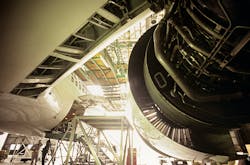Using lasers to remove corrosion, grease, residue, and existing coatings for aircraft MROs
Fort Atkinson, Wis., - Most aircraft MROs understand the value of pretreating the metal surfaces of parts to remove corrosion, grease, residue, old coatings, or to roughen the surface of metals prior to coating. By ensuring the items are cleaned down to bare metal, aircraft MROs can avoid costly warranty issues that result when coatings peel, flake, bubble, or otherwise fail prematurely. The surface conditioning, cleaning, and profiling of jet engine parts may also be required to perform specific maintenance in accord with their operation specifications as FAA Certified Repair Stations, AviationPros reports. Continue reading original article.
The Military & Aerospace Electronics take:
31 July 2023 - Laser-based systems have significant advantages over traditional methods, including ease of use in which an operator simply points and clicks a high-energy laser beam at the surface. The substrate is not affected by the laser, and the systems do not create any mess or byproducts. The approach is eco-friendly, energy-efficient, and completes the job in half the time of traditional methods when preparation and cleanup are considered.
“In our experience, laser cleaning is as fast at removing rust or old coatings as other methods, but without the same amount of cleanup,” said Galiardi. “When we treat a surface with lasers, any fumes or dislodged particulate is extracted into a HEPA filter and the job is done. There is no media [sand, dry ice, chemicals] to replenish or clean up.”
Galiardi Laser Clean uses laser systems made by Orlando, Florida-based Laser Photonics, a leading provider of patented industrial grade CleanTech laser systems for cleaning and surface conditioning. The American-made systems function either as mobile standalone units or can be integrated into production lines.
The laser systems are available in portable and stationary models ranging from 50 to 3,000 watts (a 4,000-watt version is in development) with chamber sizes from 3’ x 3’ in size to 6’ x 12’. The systems can also be installed in manufacturing lines in cabinets or operated by a robotic arm.
Related: MRO outlook report: Tech eases challenges
Related: Pulse Aviation chooses Embraer-X's Beacon MRO platform
Related: Air China and Rolls-Royce announce new MRO facility in Beijing
Jamie Whitney, Senior Editor
Military + Aerospace Electronics
